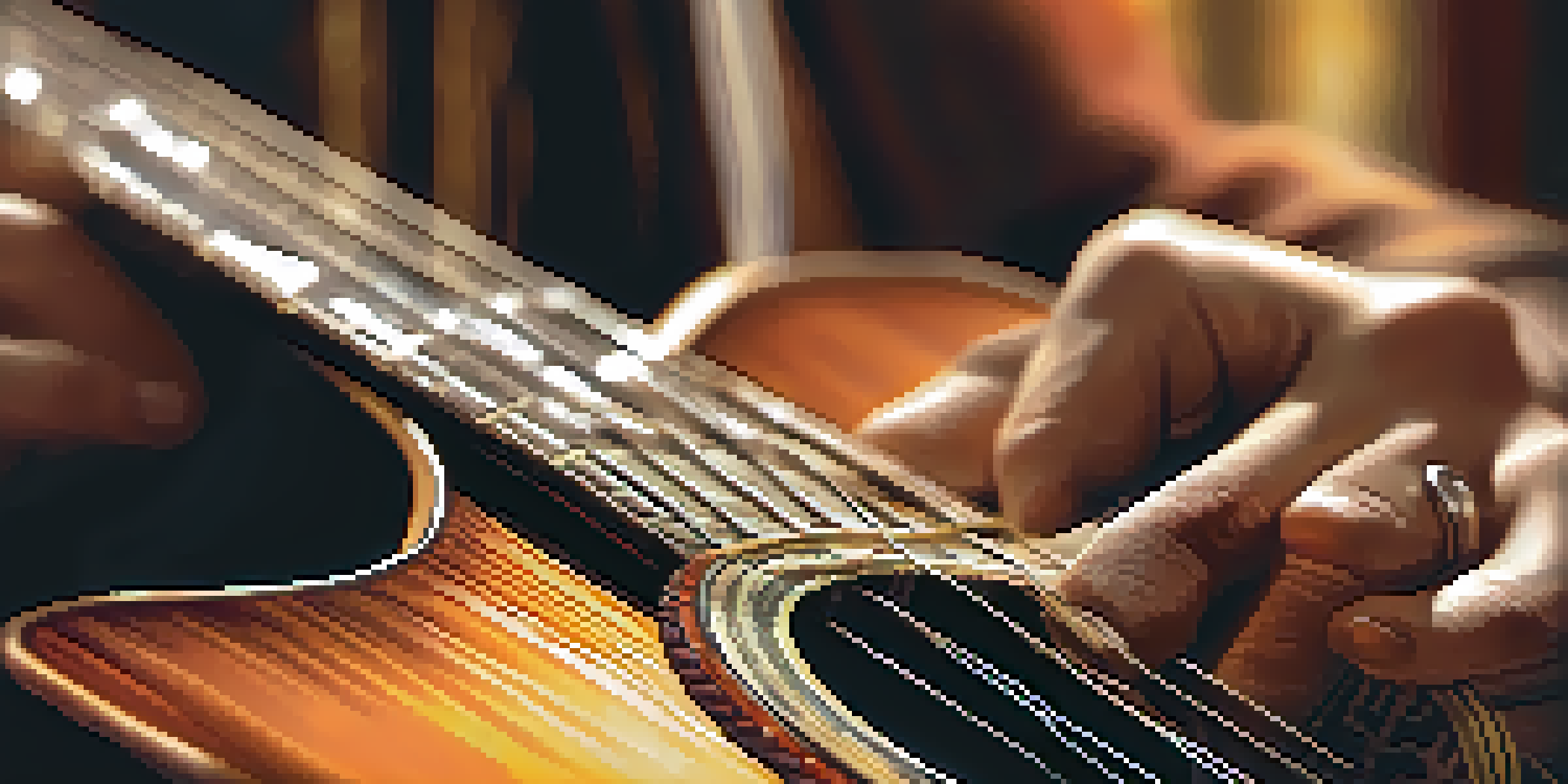Creating Tension and Release in Guitar Improvisation

Understanding Tension and Release in Music
Tension and release are fundamental concepts in music that create emotional dynamics. Think of it like a thrilling rollercoaster ride; the build-up of anticipation (tension) makes the eventual drop (release) exhilarating. In guitar improvisation, these elements can captivate your audience and make your solos memorable.
Music is the shorthand of emotion.
Musically, tension can be created through various techniques such as dissonance, rhythmic complexity, or a sudden change in dynamics. When you play a note that feels unresolved, it creates a sense of yearning in the listener. This yearning keeps them engaged, waiting for the moment of release that follows.
Release provides a resolution, bringing the listener back to a state of comfort. In your improvisation, resolving those tense moments with satisfying chords or melodies can be like a breath of fresh air after a long dive underwater. Mastering this balance is key to creating compelling music.
Building Tension Through Dissonance
Dissonance can be a powerful tool for building tension in your guitar solos. When you use notes that clash against the underlying harmony, it creates a sense of unease, which can be incredibly effective. For instance, playing a sharp note against a major chord can evoke a feeling of tension that begs for resolution.

To effectively use dissonance, consider how it fits within your improvisational context. A well-placed dissonant note can elevate a solo, making it more expressive. Trials and errors will help you discover the sweet spots where dissonance enhances rather than overwhelms your melody.
Emotional Dynamics in Music
Tension and release create emotional dynamics that enhance the engagement of listeners during musical performances.
Remember, the goal is not to create chaos but to enhance the emotional journey of your music. By strategically placing dissonant notes, you prepare your listeners for the satisfying release that follows, making your solos more engaging and impactful.
Utilizing Rhythm to Create Tension
Rhythm plays a crucial role in establishing tension. By playing with syncopation or altering your note durations, you can create a sense of unpredictability. This unpredictability keeps your audience on their toes, enhancing the overall tension in your improvisation.
The best way to express your feelings is through music.
For example, if you normally play in a steady eighth-note rhythm, introducing a triplet or a sudden pause can create an unexpected twist. This rhythmic variation can feel jarring but adds to the tension, making the eventual resolution more satisfying.
Experimenting with different rhythmic patterns can open up new avenues for creativity in your improvisation. As you play around with these rhythms, listen closely to how they impact the tension and release within your piece, allowing you to refine your approach.
Creating Melodic Tension Through Pitch Choices
Melodic tension often arises from specific pitch choices, particularly when using notes that are not part of the underlying scale or harmony. By incorporating these 'out-of-scale' notes, you can create an intriguing tension that piques the listener's interest. Think of it like adding a splash of unexpected color to a painting.
To effectively use pitch for tension, try bending notes or using slides to emphasize certain parts of your melody. These techniques can make the notes feel more expressive and emotionally charged. The key is to know when to introduce these elements to maximize their impact.
Techniques for Building Tension
Dissonance, rhythm, pitch choices, and dynamics are effective techniques for building tension in guitar improvisation.
Once you've established melodic tension, you'll want to resolve it with a return to more stable notes. This contrast between tension and resolution can evoke strong emotional responses, making your improvisation feel more dynamic and relatable.
The Role of Dynamics in Tension and Release
Dynamics, or the variations in loudness, are crucial for creating tension and release in music. A sudden increase in volume can heighten the emotional stakes, while a soft passage can provide a soothing release. Think of it like the ebb and flow of a conversation, where the volume can dictate the mood.
In your guitar solos, try experimenting with swells or sudden drops in dynamics. For instance, building up to a crescendo before releasing into a softer, reflective section can create a compelling narrative within your music. This interplay of loud and soft can keep your listeners engaged.
By mastering the use of dynamics, you can add another layer of emotional depth to your improvisation. The more you play with these contrasts, the more you'll discover how they can enhance the overall tension and release in your solos.
Using Space to Create Anticipation
Space, or silence, can be a powerful tool in your improvisational arsenal. By incorporating pauses or rests into your playing, you can create a sense of anticipation that draws the listener in. It's like holding your breath before a big reveal; the moment feels heavier and more impactful.
Incorporating space means being intentional about when to play and when to hold back. This can create a dramatic tension that makes the release feel even more rewarding. Think of it as a suspenseful moment in a movie where the silence amplifies the upcoming action.
Exercises for Mastery
Practicing specific exercises focused on tension and release will help musicians develop a greater control over their improvisational choices.
Experiment with different lengths of pauses to see how they affect the overall feel of your piece. The right amount of space can help you build a captivating musical narrative that keeps your audience engaged and emotionally invested.
Practical Exercises for Tension and Release
To truly master the concepts of tension and release, it's essential to practice specific exercises. One effective exercise is to create a short solo focusing solely on building tension. Use dissonance, rhythmic variations, and dynamic shifts to see how far you can push the tension before resolving it.
Another exercise involves improvising a melody that alternates between tense and relaxing sections. This can help you become more aware of how tension and release work together. By playing back and forth between these two states, you can develop a greater sense of control over your improvisational choices.

Finally, try recording your improvisations and listening back. This will give you insight into how effectively you create tension and release. Over time, you'll develop a more intuitive understanding of these concepts, allowing you to incorporate them naturally into your playing.